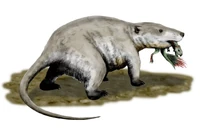A few years ago, I visited Liaoning Province in China, to study the region’s famous feather-covered dinosaur fossils. One day, after many hours of measuring bones and photographing feathers in a museum, I needed a break.
My Chinese colleagues exchanged a few hushed words of Mandarin and motioned for me to follow. “We have something secret to show you,” one of them said. “And it’s not a dinosaur.”
We left the museum, hopped into a car, and snaked through the narrow streets of Beipiao city, clogged with bicycles and noodle vendors. We pulled into an alleyway that opened into a small courtyard. Into a dark apartment we ventured, sidestepping a clutter of boxes and wooden crates.
One of my colleagues ducked into a side room and came out holding two rock slabs that fitted together like a jigsaw puzzle. On the surface was a brown smear, about the size of an apple


